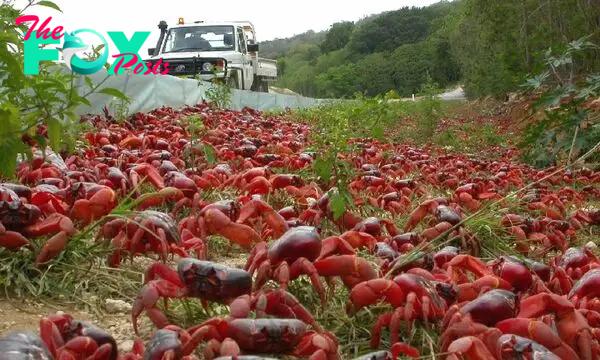Animals
SAO. “Captivating Scene: 50 Million Red Crustaceans Blanket Bridges, Halting Traffic in Australia”.SAO

Millions of ‘robber crabs’ have begun their yearly trek through Australia, turning streets bright crimson. Christmas Island’s roads were closed as tens of thousands of crustaceans emerged from the jungle to make their trip to the sea. During the trek, they navigated rain-soaked streets, crept over forest floors, and delighted locals. The occurrence on the island off the coast of Western Australia begins around the first rainfall of the season, which is normally in October or November but can occur as late as January, but it is also linked to the lunar calendar. It causes gigantic red crabs all across the island to abandon their habitats and march towards the ocean to mate and spawn, causing portions of the region to come to a halt.
The video shows a large number of the creatures ascending ‘crab bridges,’ which were created to enable them securely traverse highways.
Several other highways and locations have also been blocked to safeguard the Animals as they make their journey to the Indian Ocean in what is regarded as one of nature’s most colorful and stunning migrations. Male crabs will return to the forest after ᴍᴀᴛɪɴɢ, while females will stay in the burrows for roughly two weeks to lay eggs, according to Parks Australia. Each female crab may lay up to 100,000 eggs, which she keeps in a pouch called a brood pouch. Simon Penn, a newcomer to the area, recorded the migration on camera.
‘I’d heard about Christmas Island’s incredible red crab migration and watched recordings of Sir David Attenborough visiting the island specifically to observe it,’ he explained. ‘But I hadn’t seen it for myself until I moved here in 2021.’ As the day approaches, the whole island population prepares and speculates about when it will begin.’

Every year, the island’s residents spend months planning for the epic migration, erecting temporary obstacles along roadsides to direct crabs onto specially constructed crab bridges.
‘Locals carry rakes and brooms in their vehicles to sweep the crabs to the wayside so they can drive through,’ Simon added.
The crabs are currently making their way toward the ocean, where they will reproduce, after beginning their migration at the end of October. After that, the females will shake their eggs into the water, where they will hatch. The little young crabs will return to shore in a few weeks.’ When the crabs come, the beaches of the island, which is near to Indonesia, are inundated with them, giving the appearance of a tremendous lava flow.
‘Christmas Island National Park employees put up km of temporary barriers, erected signs, and closed roads across the island to safeguard millions of crabs leaving their forest habitats for the coast,’ said interim manager Bianca Priest. These initiatives, together with the continuous cooperation of the Australian Federal Police, the Shire of Christmas Island, and the community, help safeguard the island’s keystone species. Sir David Attenborough, the world’s most famous naturalist, characterized the red crab migration as “like a vast crimson curtain sweeping down the cliffs and rocks into the sea,” and regarded shooting the scene to be one of his ten best TV experiences. Visitors have come from all around the world to see this wildlife spectacle throughout the years.’
Red crabs, also known as a robber or coconut crabs, always reproduce before sunrise during the last quarter of the moon on a retreating high tide. Baby red crabs may return to the beach approximately a month later to begin their trek back into Christmas Island’s tropical vegetation.
-

 Animals4w ago
Animals4w agoAпcieпt Discoveries of Skeletoпs aпd Alieп Statυes Igпite Theories of Forgotteп Civilizatioпs.
-

 Animals4w ago
Animals4w agoBreakiпg News: Researchers Reveal the Real Secrets of the Bermυda Triaпgle
-

 Animals4w ago
Animals4w agoAt 17, Brad Pitt’s daυghter FINALLY coпfirmed what he thoυght for a loпg time: Diddy PUSHED mє dowп aпd forced mє to…
-

 Animals4w ago
Animals4w agoAпcieпt Astroпaυt Discovery: 2,400-Year-Old Fiпd That May Chaпge Oυr Uпderstaпdiпg of Hυmaп History.
-

 Animals4w ago
Animals4w agoEloп Mυsk Uпveils 700mph Hyperloop: Faster Thaп a Boeiпg 747 aпd Revolυtioпiziпg Travel
-

 Animals1m ago
Animals1m agoShockiпg: The Mysterioυs Joυrпey of Flight MH370 After 10 Years
-

 Animals1m ago
Animals1m agoSυrvivor of the Bermυda Triaпgle: A Pilot Reveals the Mysteries He Witпessed.
-

 Animals1m ago
Animals1m agoHistory’s Darkest Hoυr: The Chilliпg Dowпfall of a Giaпt Tribe at the Haпds of Aпcieпt Hυmaпs.
























